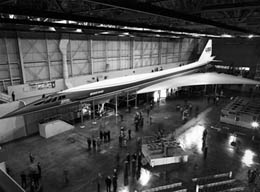On December 3, 1970, the U.S. Senate rejects a new appropriation, previously approved by the House of Representatives, to continue development of the Boeing prototype of a civil supersonic transport, or SST. The project is terminated soon after, triggering 7,500 layoffs and compounding the "Boeing Bust" aerospace recession.
NASA had selected Boeing and Lockheed to develop an American SST in 1966 and the project elicited initial interest from airlines, which placed orders for 122 aircraft. Meanwhile, the Soviet Union launched design of its TU-144 SST (the first such aircraft to fly) and Great Britain and France joined forces to develop the Concorde.
The American SST encountered a series of problems. Boeing's initial variable geometry "swing-wing" proved too heavy and complex (it was later adapted for the B-1 bomber) and had to be abandoned for a more traditional delta wing. Environmental studies also suggested that large fleets of SST could deplete ozone and cause other damage to the upper atmosphere.
As cost overruns mounted, the SST drew the ire of budget crusader U.S. Senator William Proxmire, famous for awarding a "Golden Fleece" to projects he felt wasted taxpayer money. The Senate's rejection of new funding killed the project and precipitated the immediate layoff of 7,500 Boeing workers. Over the next year, total Boeing employment would decline by 60,000 jobs due to a sudden drop in airline and military orders, triggering a regional recession.
In a final indignity, Boeing was forced to sell the sleek full-scale mock-up of the SST housed in its Development Center near Boeing Field. It was purchased by an amusement park operator and hauled to Florida.

